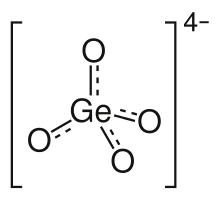Germanate
In chemistry, germanate is a compound containing an oxyanion of germanium. In the naming of inorganic compounds it is a suffix that indicates a polyatomic anion with a central germanium atom,[1] for example potassium hexafluorogermanate, K2GeF6.[2]

Germanate oxy compounds
Germanium is similar to silicon forming many compounds with tetrahedral {GeO4}[2] units although it can also exhibit 5[3] and 6[2] coordination. Analogues of all the major types of silicates and aluminosilicates have been prepared.[4] For example, the compounds Mg2GeO4 (olivine and spinel forms), CaGeO3(perovskite structure), Be2GeO4 (phenakite structure) show the resemblance to the silicates.[4][5] BaGe4O9 has a complex structure containing 4 and 6 coordinate germanium.[5] Germanates are important for geoscience as they possess similar structures to silicates and can be used as analogues for studying the behaviour of silicate minerals found in the Earth's mantle;[6] for example, MnGeO3 has a pyroxene type structure similar to that of MgSiO3 which is a significant mineral in the mantle.[7][8][9]
Germanates in aqueous solutions
The alkali metal orthogermanates, M4GeO4,containing discrete GeO4−
4 ions, form acidic solutions containing GeO(OH)−
3, GeO
2(OH)2−
2 and [(Ge(OH)4)8(OH)3]3−.[2] Neutral solutions of germanium dioxide contain Ge(OH)4, but at high pH germanate ions such as GeO(OH)−
3, GeO
2(OH)2−
2 are present.[10]
Germanate zeolites
Microporous germanate zeolites were first prepared in the 1990s.[11][12] A common method of preparation is hydrothermal synthesis using an organic amine as a template (structure determining agent).[13] The frameworks are negatively charged due to extra oxide ions which leads to higher coordination numbers for germanium of 5 and 6. The negative charge is balanced by the positively charged amine molecules.
In addition to the ability of germanium to exhibit 4, 5 or 6 coordination, the greater length of the Ge–O bond in the {GeO4} tetrahedral unit compared to Si–O in {SiO4} and the narrower Ge–O–Ge angle (130°–140°) between corner shared tetrahedra allow for unusual framework structures.[14] A zeolite reported in 2005[15] has large pores – 18.6 × 26.2 Å interconnected by channels defined by 30-membered rings (the naturally occurring zeolite faujasite with channels defined by 12-membered rings[16]). Zeolites with frameworks containing silicon and germanium (silicogermanates), aluminium and germanium (aluminogermanates) and zirconium and germanium (zirconogermanates) are all known.[13][17]
See also
- Bismuth germanate (bismuth germanium oxide, BGO)
- Sodium germanate
References
- Nomenclature of Inorganic Chemistry IUPAC Recommendations 2005 – Full text (PDF)
- Egon Wiberg, Arnold Frederick Holleman (2001) Inorganic Chemistry, Elsevier ISBN 0123526515
- Nguyen, Quang Bac; Lii, Kwang-Hwa (2011). "Cs4UGe8O20: A Tetravalent Uranium Germanate Containing Four- and Five-Coordinate Germanium". Inorganic Chemistry. 50 (20): 9936–9938. doi:10.1021/ic201789f. ISSN 0020-1669.
- Greenwood, Norman N.; Earnshaw, Alan (1997). Chemistry of the Elements (2nd ed.). Butterworth-Heinemann. ISBN 978-0-08-037941-8.
- Encyclopedia of alkaline earth compounds R.C Ropp, Elsevier 2013 ISBN 978-0-444-59550-8
- Ringwood, A.E. (1970). "Phase transformations and the constitution of the mantle". Physics of the Earth and Planetary Interiors. 3: 109–155. Bibcode:1970PEPI....3..109R. doi:10.1016/0031-9201(70)90047-6. ISSN 0031-9201.
- Ringwood, A. E.; Seabrook, Merren (1962). "Some High-pressure Transformations in Pyroxenes". Nature. 196 (4857): 883–884. Bibcode:1962Natur.196..883R. doi:10.1038/196883a0. ISSN 0028-0836.
- Hirose, Kei; Nagaya, Yukio; Merkel, Sébastien; Ohishi, Yasuo (2010). "Deformation of MnGeO3 post-perovskite at lower mantle pressure and temperature". Geophysical Research Letters. 37 (20). Bibcode:2010GeoRL..3720302H. doi:10.1029/2010GL044977. ISSN 0094-8276.
- Matsumura, Hisashi; Mamiya, Mikito; Takei, Humihiko (2000). "Growth of pyroxene-type MnGeO3 and (Mn,Mg)GeO3 crystals by the floating-zone method". Journal of Crystal Growth. 210 (4): 783–787. Bibcode:2000JCrGr.210..783M. doi:10.1016/S0022-0248(99)00850-7. ISSN 0022-0248.
- "Germanium: Inorganic Chemistry" F Glockling Encyclopedia of Inorganic Chemistry Editor R Bruce King (1994) John Wiley and Sons ISBN 0-471-93620-0
- Cheng, Jun; Xu, Ruren; Yang, Guangdi (1991). "Synthesis, structure and characterization of a novel germanium dioxide with occluded tetramethylammonium hydroxide". Journal of the Chemical Society, Dalton Transactions (6): 1537. doi:10.1039/dt9910001537. ISSN 0300-9246.
- Li, Hailian; Yaghi, O. M. (1998). "Transformation of Germanium Dioxide to Microporous Germanate 4-Connected Nets". Journal of the American Chemical Society. 120 (40): 10569–10570. doi:10.1021/ja982384n. ISSN 0002-7863.
- Zeolites and Related Materials: Trends Targets and Challenges(SET), 1st Edition, 4th International FEZA Conference, 2008, Paris, France; Eds. Gedeon, Massiani,Babonneau; Elsevier Science; ISBN 9780444532961
- Introduction to Zeolite Molecular Sieves, Jiri Cejka, Herman van Bekkum, A. Corma, F. Schueth, Elsevier, 2007
- Zou, Xiaodong; Conradsson, Tony; Klingstedt, Miia; Dadachov, Mike S.; O'Keeffe, Michael (2005). "A mesoporous germanium oxide with crystalline pore walls and its chiral derivative". Nature. 437 (7059): 716–719. Bibcode:2005Natur.437..716Z. doi:10.1038/nature04097. ISSN 0028-0836. PMID 16193048.
- Handbook Of Molecular Sieves: Structures, Rosemarie Szostak, 1992, Van Nostrand Reinhold, ISBN 0442318995, ISBN 978-0442318994
- Plévert, Jacques; Sanchez-Smith, Rebeca; Gentz, Travis M.; Li, Hailian; Groy, Thomas L.; Yaghi, Omar M.; O'Keeffe, Michael (2003). "Synthesis and Characterization of Zirconogermanates". Inorganic Chemistry. 42 (19): 5954–5959. doi:10.1021/ic034298g. ISSN 0020-1669.